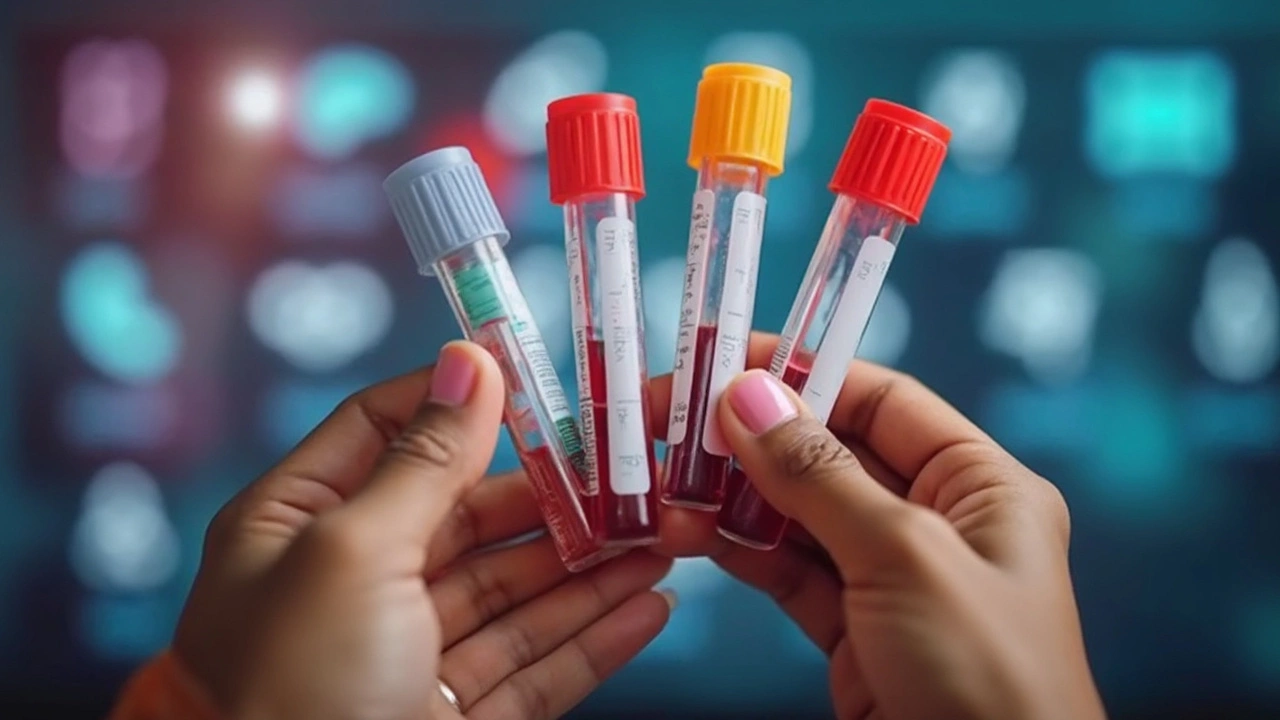
Ever wonder what exactly happens when you sign up for a full body blood test? You see those health checkup packages advertised everywhere—fancy names, flashy promises, and a long list of tests. But do you know what those tests are and why they matter?
A full body blood test usually means a bundle of different blood tests done all at once. It’s not just a single blood draw looking for one thing; it’s a line-up that checks your organs, blood sugar, cholesterol, vitamin levels, and more. These tests can spot early warning signs even when you feel totally fine. That’s how silent issues—like high cholesterol or diabetes—get found before they start causing real trouble.
Don’t worry, there’s nothing mysterious about it. In fact, knowing what’s in these tests puts you in the driver’s seat when it comes to your health. Stuck on the medical lingo in your last test report? You’re not alone. This article will help you figure out what gets tested, why doctors check it, and what your results could mean for you.
- Why Do a Full Body Blood Test?
- The Core Tests Covered
- What Each Test Actually Tells You
- Getting Ready: Tips Before You Go
- How to Make Sense of Your Results
Why Do a Full Body Blood Test?
Most people get a full body blood test when they want to understand what’s really happening inside their body—long before obvious symptoms show up. It’s like a health screenshot: this single check can show you some of the earliest signs of diabetes, heart issues, vitamin imbalances, infections, liver or kidney problems, and even some types of anemia. You probably know someone who found out about a serious issue just because of a routine blood test. That’s not luck—it’s science doing its job.
There are a few top reasons people actually go for these complete panels:
- Preventive health: Even if you feel good, a full blood test helps spot sneaky issues, like pre-diabetes or high cholesterol. This means you and your doctor can tackle stuff before it blows up into something bigger.
- Tracking new symptoms: Got unexplained tiredness or weird aches? Doctors often start with a thorough blood test. It covers multiple body systems at once, saving time and guesswork.
- Family history: If your parents or siblings have conditions like heart disease, diabetes, or certain cancers, it’s smart to get screened regularly. Blood tests help catch risks you can’t see or feel yet.
- Lifestyle changes: Starting a new workout, diet, or treatment? Blood tests can show how those changes are affecting things like your sugar, cholesterol, or liver function. It gives you actual numbers, not just guesswork.
Some companies now offer blood test packages for workplace health checks or annual employee screenings. If your job is demanding or stressful, these tests are a practical way to keep an eye on your health without waiting for things to go wrong.
Reality check: you don’t have to be sick to get real value from a blood test. Most big hospitals or labs recommend getting these done at least once a year after age 30, even earlier if you’re at higher risk. The point is to catch things early and avoid nasty surprises.
The Core Tests Covered
A full body blood test isn’t just a random set of checks. It covers the major stuff doctors want to see when they’re figuring out how your body’s running under the hood. Here’s what usually ends up in the package:
- Complete Blood Count (CBC): This is the starting point. It checks red and white blood cells, hemoglobin, platelets. Think of it like a snapshot of your blood’s main players—keeping an eye out for infections, anemia, or even early signs of certain cancers.
- Blood Sugar (Fasting and Post-Meal): Catches early signs of diabetes. Doctors usually look at both your fasting level and how your blood sugar jumps after you eat.
- Lipid Profile: This looks at cholesterol (good and bad), triglycerides, and a few other fats in your blood. High numbers could mean you’re at risk for heart disease.
- Liver Function Test (LFT): Checks how your liver is doing with numbers like ALT, AST, bilirubin, and proteins. Surprising fact: fatty liver can start in your twenties, even if you’re slim.
- Kidney Function Test (KFT): Picks up early trouble before you feel sick at all. This test tracks levels like creatinine and urea.
- Thyroid Function Test: Checks T3, T4, and TSH. Thyroid issues are way more common than people think, especially in women.
- Vitamin D and B12: Deficiency is almost an epidemic now, thanks to indoor lifestyles and diet trends. Low levels lead to fatigue and mood swings you might never blame on vitamins.
- Iron Studies: Looks at iron, ferritin, and how much your blood is carrying. More useful than a casual ‘eat more spinach’ tip—this can spot real deficiencies or overloads.
- ESR and CRP: These flag general inflammation. Sometimes, these are the first hint that something’s off before other symptoms show up.
Certain tests might vary based on age, personal risks, or package pricing, but these are the heart of most packages.
| Test Name | Checks For | Normal Range (Typical Adult) |
|---|---|---|
| CBC | Anemia, infection, general blood health | WBC: 4,000–11,000 cells/μL RBC: 4.5–5.9 million cells/μL (men) |
| Blood Sugar (Fasting) | Diabetes risk | 70–99 mg/dL |
| Lipid Profile | Heart health risk | LDL: <100 mg/dL HDL: >40 mg/dL (men) |
| Liver Function (ALT/AST) | Liver damage or stress | ALT: 7–56 U/L |
| Kidney Function (Creatinine) | Kidney health | 0.7–1.3 mg/dL (men) |
If you want a health checkup that really gives you the full story, make sure your package ticks off these tests. Having numbers for each one makes it easier to catch small problems before they become big headaches later on.

What Each Test Actually Tells You
Just getting a bunch of numbers on a report means nothing unless you know what those numbers show. Here’s what the usual tests in a full body blood test actually look for, and what the results can mean for you.
- Complete Blood Count (CBC): This checks your red blood cells, white blood cells, hemoglobin, and platelets. Low red cells? You might be dealing with anemia. Too many white cells? That could point to infection or inflammation.
- Blood Sugar (Glucose Fasting/PP): High fasting blood sugar is a red flag for diabetes risk. Low? You might be skipping meals or have another issue with blood sugar regulation.
- Liver Function Test (LFT): Measures enzymes and proteins made by your liver—tells you if there’s liver trouble, like hepatitis or heavy drinking damage. High bilirubin? That could mean jaundice or liver disease.
- Kidney Function Test (KFT): Checks how well your kidneys clear waste. Abnormal urea or creatinine levels? It could be due to dehydration or chronic kidney issues.
- Lipid Profile: Looks at cholesterol (HDL, LDL, triglycerides). Too much bad cholesterol (LDL) and low good cholesterol (HDL) both bump up your heart disease risk.
- Thyroid Function Test (T3, T4, TSH): Out-of-range thyroid hormones can explain tiredness, weight changes, or mood swings.
- Vitamin B12 and D Levels: Deficiencies here are super common—low vitamin D means weak bones and low energy, low B12 can mess with nerves and your mood.
And here’s a quick look at some normal reference values you’ll probably come across (these numbers can differ slightly by lab and age group):
| Test | Normal Range | What It Means |
|---|---|---|
| Hemoglobin | 13-17 g/dl (Men), 12-15 g/dl (Women) | Oxygen-carrying protein; low is anemia |
| Fasting Blood Sugar | 70-99 mg/dl | High signals diabetes risk |
| ALT (Liver) | 7-56 U/L | Elevated = possible liver damage |
| Serum Creatinine | 0.7-1.2 mg/dl | High = possible kidney trouble |
| Total Cholesterol | Below 200 mg/dl | High = heart risk |
| TSH | 0.4-4.0 mIU/L | High or low = thyroid problems |
| Vitamin D | 30-100 ng/ml | Low = weak bones, low immunity |
Dr. Anjali Mishra, who leads preventive health at a major Mumbai hospital, puts it like this:
“Blood tests can catch serious health risks before symptoms ever show up. Reading the numbers with your doctor can help you make real changes—not just spot trouble but prevent it.”
So, next time you get your blood checked, don’t just file the report away. Ask what each result means for you. And remember, a single number out of range isn’t always a disaster—your doctor will look at the full story, not just one test.
Getting Ready: Tips Before You Go
Showing up unprepared for a full body blood test can mess with your results. The whole point is to get a clear shot of what’s really happening in your body, not just how things look after breakfast or a late-night snack. Here’s what you need to know before you head in.
- Fasting is often a must. Most panels (like blood sugar or cholesterol) want you to fast for at least 8–12 hours. Only water is okay—coffee, tea, or juice can throw things off.
- Take your regular meds… mostly. If you’re on daily prescriptions, ask your doctor which ones you can take before the test. Don’t just skip meds on guesswork.
- Avoid heavy workouts the night before. Intense exercise can shake up your enzyme levels and make markers like creatinine run high.
- Cut back on alcohol and fatty foods a day or two ahead. These can mess up liver function results and cholesterol numbers.
- Mention any symptoms or supplements. Jot down anything new you’ve noticed or supplements you take. Some vitamins or herbal stuff can affect certain blood markers.
Wondering why all this matters? Even a single sugary drink or herbal tea can change your glucose or kidney test numbers. Stats show that up to 15% of initial blood test results are slightly off just because of missed prep rules.
| Prep Step | What It Affects |
|---|---|
| Fasting (8–12 hrs) | Glucose, cholesterol, triglycerides |
| No alcohol 24 hrs before | Liver function, lipid profile |
| Avoid fatty meals 24 hrs before | Cholesterol, liver enzymes |
| Skip heavy exercise 24 hrs before | Enzymes (CK, AST), creatinine |
If you have a bad cold, weird symptoms, or your period, let the lab know—these things can alter your results too. Write down any questions or worries before you go. It’s your test, and you deserve clear answers.

How to Make Sense of Your Results
Getting your blood test report can feel confusing. Numbers everywhere, strange abbreviations, and a sea of ranges and highlights. So, where do you even begin?
First, take a breath. Your test will usually list your value alongside a “reference range.” This range is what’s considered normal for most healthy people. Spot something outside the range? It’s useful information, but don’t freak out—one off number doesn’t always mean you’re sick. Lab values can swing a bit for reasons like recent food, stress, or even how much water you drank.
Here’s what to do when you get your report:
- Full body blood test results usually include a summary or flag anything abnormal—look for words like "HIGH" or "LOW" next to your numbers.
- Compare your numbers to the reference range printed alongside. Slight dips and rises sometimes aren’t a big deal, especially if you’re not feeling unwell.
- If something's in bold or flagged, write it down or highlight it to discuss with your doctor—even if you think you know what it means.
- Notice patterns—like several liver or kidney markers trending out of range. Patterns are more telling than a single offbeat number.
- Always check for advice written on the report. Labs sometimes include quick notes if your results need urgent attention.
When you meet your doctor, have your questions ready. Ask if your results suggest any immediate action, lifestyle changes, or repeat testing. It's not about memorizing every abbreviation—it's about understanding trends in your health. If your doctor uses jargon, don’t be shy. Just ask: “What does that mean for me right now?”
One more tip: Keep records. Tracking your reports over the years shows your baselines and helps spot real changes. You might even notice you always run a little high or low on certain markers, which your doctor can explain.
So, if you notice something off in your results, don’t hit the panic button. See it as a chance to tweak your routine or catch a problem early. That’s the real reason these tests are so valuable.





Rohan Talvani
I am a manufacturing expert with over 15 years of experience in streamlining production processes and enhancing operational efficiency. My work often takes me into the technical nitty-gritty of production, but I have a keen interest in writing about medicine in India—an intersection of tradition and modern practices that captivates me. I strive to incorporate innovative approaches in everything I do, whether in my professional role or as an author. My passion for writing about health topics stems from a strong belief in knowledge sharing and its potential to bring about positive changes.
view all postsWrite a comment